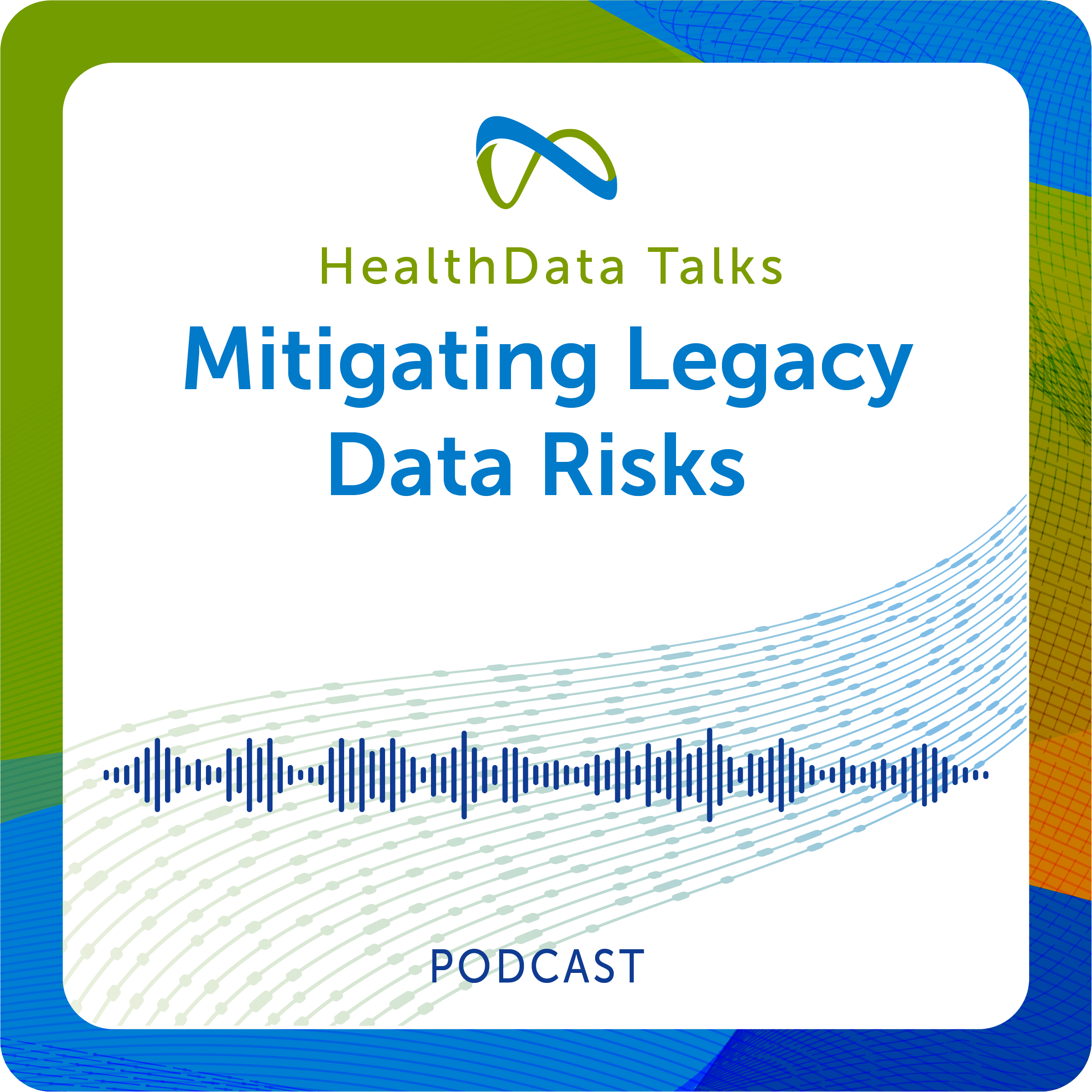[00:00:05] Speaker A: Welcome to Health Data Talks where industry.
[00:00:07] Speaker B: Experts offer bite sized tips and trends for managing legacy data.
Thanks for joining us. I'm Eric Johnson from Harmony Healthcare IT and I'm joined today with my colleague John Jonas who's a product manager here at Harmony Healthcare it.
Today we're going to talk about data storage, specifically how organizations storage needs vary in how we can scale effectively.
So welcome John, it's great to have you here today.
[00:00:35] Speaker A: Thanks for having me. Excited to talk about it.
[00:00:38] Speaker B: Excellent.
John, before we dive in into our topic for today, do you mind just giving a brief intro on yourself and your role here at Harmony?
[00:00:50] Speaker A: Of course. I have almost 10 years of experience with Harmony Healthcare IT.
I am a former operational team member and have been involved with hundreds of implementations of Harmony's products.
Right now I currently am the product manager of our inactive and active archival solutions with inactive archival being the focus of our conversation today.
[00:01:15] Speaker B: Yeah, excellent. I'm excited to dive in with that today, John.
[00:01:20] Speaker A: So.
[00:01:21] Speaker B: Well, let's get right into it.
Obviously organizations today in health care are dealing with just a ton of data from real time transactions to historical records.
So the real question is, is how do we decide what gets stored where. Right.
And you know, not all data storage is the same. Right. And hence why we're going to take today to really kind of clarify what that means. So let's get in and maybe if we could just talk a little bit about the basics and we've got really three main types. So John, do you mind just going into just kind of talking a little bit about what those solutions look like and what we offer there?
[00:02:03] Speaker A: Certainly we can start off with our active storage. For active storage solutions think of real time data access, frequently used files and immediate availability.
Our product is called Health Data Archiver. That is our active storage solution which provides frequent access to patient data in an easy to deliver format to accommodate all kinds of patient data requests. Many features exist to help organizations regulate their data to ensure HIPAA compliance. While clinical data is the primary use case, employee and financial data are also candidates for active archival.
This will utilize the fastest storage technologies to ensure quick and reliable experiences when retrieving information.
So in addition to our active storage, we have products for cold storage. When you think of cold storage, think of long term archives, backups and compliance records that don't need instant retrieval. For cold storage we have Health Data Locker tier one and tier two and the data that lands in these tiers. For Health Data locker is business critical data that is rarely needed for business operations. It utilizes storage technology that is reliable but is less performant than other archival solutions. This helps reduce costs for customers by storing rarely needed files on cost effective storage technology.
And this would require support intervention to access the data. So it is, it is about as cold as cold storage can get.
And then moving on to our warm storage.
This is kind of the middle ground. This is data that is accessed occasionally but not every second, more of a daily interval. And for this we have Health Data Locker Tier 3. This is our new product offering that utilizes our warm storage technology and allows customers a self service experience when interacting with files stored within it.
Users can search, upload and download files and admins can provision their users to have access to various groups of files.
The data stored in Health Data Locker Tier 3 utilizes storage technology right in the middle of our cold storage solution and our active storage solution. With users interacting with these files daily. A faster storage solution is needed to ensure a quick and reliable experience, but not to the same extent as the active storage solutions.
That's kind of the summary of the three different storage types with our products in between.
[00:04:46] Speaker B: Yeah, that's excellent.
I mean one thing that fascinates me about storage options and sometimes just the term archive gives a sense that it's data that's actually going to be locked away and, and not accessible. Right. So you know, helping our users understand that there's variations to having that data available all the way up to literally with inside the clinical workflow. Right. So especially when you're talking about, you know, our active archive solution. But kind of going back to tier three here a bit, can you go into just a little bit more detail John, on why Tier 3 warm storage is really an attractive option and in this case who do we typically, you know, who is typical buyer maybe for that kind of solution or user of that kind of solution?
[00:05:43] Speaker A: Yeah, it really the use cases for warm storage opens up a lot. It doesn't necessarily need to be patient data. It can be, you know, a typical buyer may be a department head, just somebody who needs to have reliable safe storage where their team can access it daily.
This is really the big differentiator from the Tier 1 and Tier 2 solutions is any user provision in Health Data Locker Tier 3 can access the files as often as they need to.
That's what we feel the biggest differentiator is. There's no support intervention.
At the same time, there's not the level of features and functionality that's available in our active storage solution.
So by kind of getting in the middle there, this data may not necessarily be clinical. It May not be patient data, but it's things files your team needs to deliver business critical functions.
We can store that information in a cost effective solution that that is HIPAA compliant and making sure that your organization's data stays safe and secure while not spending the top tier amount to store that data.
[00:07:05] Speaker B: Nice.
John, one question I have is how search ready is this kind of data?
Obviously maybe can you talk about that capability at this tier level?
[00:07:19] Speaker A: Yeah, so we collect a lot of normal file level information. File name, file type, file size and storage date.
Those standard fields are available to be searched on when you upload new files. Those fields are automatically configured to be able to be searchable.
We really let the user search based on those main file properties and that way they are able to search and find the files they need very quickly and download them to their machines.
[00:07:56] Speaker B: Nice. Excellent.
Well, maybe let's just talk a little bit about the cost differentiation between these offerings. Right. So with obviously each of these tiers comes different capabilities, different features, accessibility.
Maybe can you just kind of talk about some of those trade offs between these as customers considered, hey, what's the best choice for me and maybe just some understanding of the financial implication for each of those.
[00:08:30] Speaker A: Absolutely, yeah. Applications with high usage should return data immediately to help their users accomplish tasks as quickly as possible.
Systems that require this performance will have higher costs due to the performance of the technology powering the products.
Our active warm and cold storage solutions ensure our customers storing their data on cost effective technology for their usage needs.
Specifically, warm and cold storage solutions are an opportunity for customers to save on storage costs if the data meets the required criteria. Is the data needed for potential release of information requests? If yes, then active storage would be recommended.
Has the data been pulled or modified in the last three years? If yes, then active storage would likely be recommended. So what we're really getting at here is we want to make sure that the way the customer plans to use the data matches the storage technology behind it. And by kind of synchronizing those two use cases, it can ensure customers spend the appropriate amount of money on each technology.
[00:09:40] Speaker B: Yeah, absolutely. Makes sense.
Well, maybe as we wrap some things up here and talking about tier three, why, why does this storage option end up being the best for those certain types of use cases? And, and you know, when you really get at trying to balance the, the, you know, the cost and accessibility equation, you know, between those two for each of those use cases, you know, ultimately maybe if you can kind of talk a little bit more about why it's the best choice for certain kinds of use cases for customers and just talk about that a little bit.
[00:10:22] Speaker A: Of course, yeah. Tier 3 health data locker Tier 3 is our one stop shop for a self service cloud storage of business critical information within health data platform.
Existing functionality pairs with this solution to give administrators familiar workflows with the new product offering. And there's with that there's limited professional service costs compared to active storage solutions, so should be a pretty big lift for our customers when you know there's significantly less data mapping that goes along, significantly less testing for health data locker tier 3 if you're not needing it for that active storage reasonings.
Users can also access and add new data as frequently as they need with Tier three. And then there's also the reduced storage cost compared to the active storage solution. So a lot of benefits towards using this type of product.
[00:11:20] Speaker B: That's excellent.
Well John, thanks for joining us today. Really appreciate this and going into additional detail about the various storage options and talking about our Tier 3 warm storage. A little bit more detail.
So thanks again for joining John. Appreciate it.
[00:11:37] Speaker A: Thanks for having me.
[00:11:39] Speaker B: And to everybody, thanks for tuning in.
Join us next time for another meaningful discussion around the management of health data.
That's it for this session of Health Data Talks. Check out helpful
[email protected] and follow us in your favorite podcast app today to catch future episodes.
[00:12:00] Speaker A: We'll see you next time.


